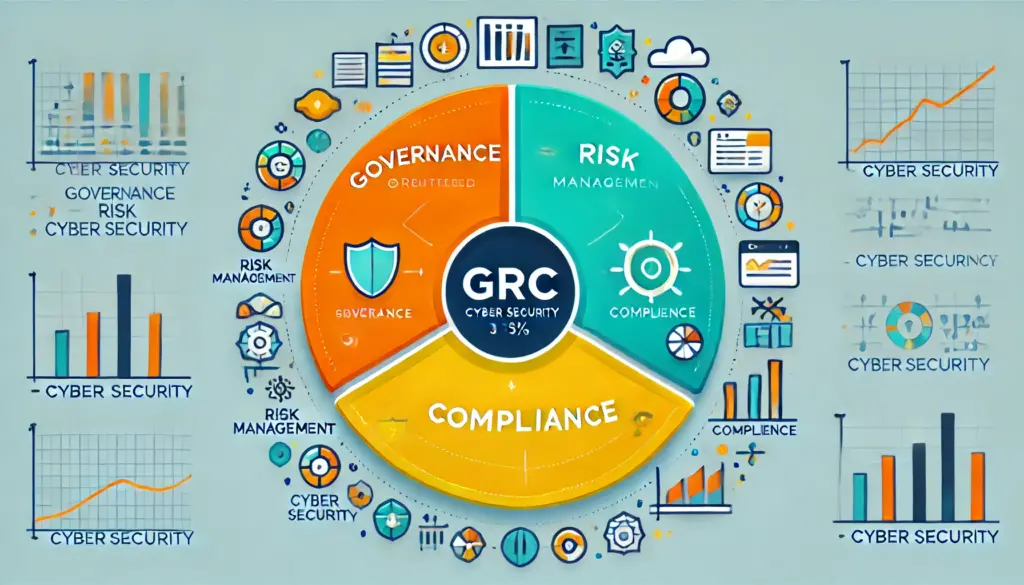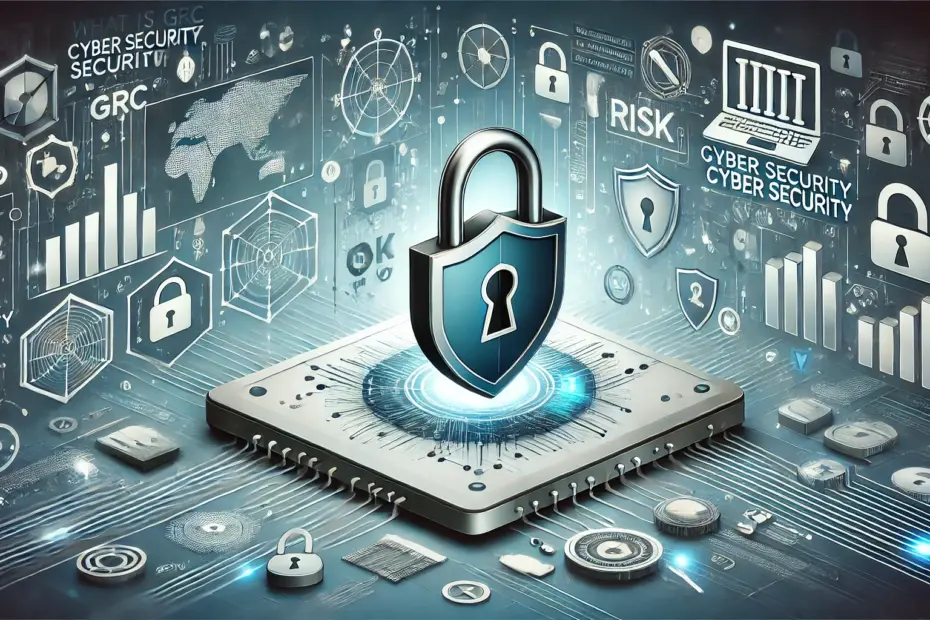Governance, Risk, and Compliance (GRC) in cybersecurity are critical elements for managing an organization's overall security posture. GRC frameworks help align IT strategies with business goals while managing risks and ensuring compliance with regulations.
Table of Contents
What is GRC in Cyber Security?
GRC cyber security refers to a strategic approach refer to a strategic approach that organizations use to manage overall governance, enterprise risk management, and regulatory compliance. GRC frameworks ensure that IT systems and business objectives are aligned, risks are effectively managed, and compliance requirements are met.
Governance involves establishing policies, procedures, and controls to ensure that an organization's IT strategy supports its business objectives. Risk management is the process of identifying, assessing, and mitigating risks that could potentially affect the organization. Compliance involves adhering to laws, regulations, and standards relevant to the organization’s industry.
Importance of GRC in Cyber Security
GRC frameworks are essential for protecting sensitive data, mitigating risks, and ensuring compliance with laws and regulations. Implementing a robust GRC cyber security strategy helps organizations to prevent security breaches, avoid fines, and maintain customer trust.
A well-implemented GRC framework can lead to improved decision-making, as it provides a comprehensive view of the organization's risk landscape. This holistic approach ensures that all potential risks are considered, and appropriate measures are taken to mitigate them. Additionally, GRC helps in maintaining a positive reputation by demonstrating the organization's commitment to security and compliance.
Components of GRC
Governance
Cybersecurity governance involves creating a structured framework for managing an organization’s cybersecurity strategies. It includes setting policies, defining roles and responsibilities, and ensuring that security measures align with business objectives. Effective governance ensures that the organization’s cybersecurity posture is proactive rather than reactive.
Governance also involves establishing a security culture within the organization. This means that all employees, from top management to entry-level staff, understand the importance of cybersecurity and their role in maintaining it. Regular training and awareness programs can help in building this culture.
Risk Management
Risk management in cybersecurity involves identifying, assessing, and mitigating risks to an organization’s information assets. This process includes conducting risk assessments, implementing controls to mitigate identified risks, and continuously monitoring for new threats. Risk management is a continuous process that evolves as new threats emerge and the organization’s risk landscape changes.
Effective risk management requires a thorough understanding of the organization’s assets and the potential threats they face. This includes both internal and external threats. Internal threats could include employee negligence or malicious insiders, while external threats could include cyber-attacks from hackers or nation-states.
Compliance
Compliance ensures that an organization meets regulatory and industry standards related to cybersecurity. This includes adhering to frameworks such as NIST, ISO 27001, and PCI DSS, which provide guidelines for maintaining robust security practices. Compliance is not just about meeting legal requirements; it also involves following best practices to ensure the highest level of security.
Compliance also involves regular audits and assessments to ensure that the organization continues to meet the required standards. This can involve both internal audits conducted by the organization’s security team and external audits conducted by third-party organizations. Regular audits help in identifying gaps and areas for improvement in the organization’s security posture.
Implementing a GRC Framework
- Assessment: Evaluate the current cybersecurity posture and identify gaps.
- Strategy Development: Develop a comprehensive GRC strategy that aligns with business objectives.
- Implementation: Deploy necessary tools and processes to manage governance, risk, and compliance.
- Monitoring and Review: Continuously monitor the effectiveness of the GRC framework and make improvements as needed.
Implementing a GRC framework involves a phased approach. The first phase involves conducting a thorough assessment of the current cybersecurity posture. This includes identifying existing policies, procedures, and controls, as well as identifying gaps and areas for improvement.
The next phase involves developing a comprehensive GRC strategy. This strategy should align with the organization’s business objectives and should be designed to address the identified gaps and areas for improvement. The strategy should also include a detailed plan for implementing the necessary tools and processes.
The final phase involves monitoring and reviewing the effectiveness of the GRC framework. This includes regularly assessing the organization’s risk landscape, conducting audits and assessments, and making necessary improvements to the GRC framework.

Benefits of GRC in Cyber Security
- Improved Risk Management: Identifies and mitigates risks effectively.
- Regulatory Compliance: Ensures adherence to legal and industry standards.
- Enhanced Decision-Making: Provides a structured approach for informed decision-making.
- Increased Efficiency: Streamlines processes and reduces redundant efforts.
- Reputation Management: Protects the organization’s reputation by preventing breaches and ensuring compliance.
Implementing a GRC cyber security framework provides numerous benefits to an organization. One of the primary benefits is improved risk management. By identifying and mitigating risks effectively, organizations can protect their information assets and reduce the likelihood of security breaches.
Regulatory compliance is another significant benefit. By adhering to legal and industry standards, organizations can avoid fines and penalties and maintain a positive reputation. This is particularly important in industries that handle sensitive information, such as healthcare and finance.
Enhanced decision-making is another benefit of a GRC framework. By providing a comprehensive view of the organization’s risk landscape, GRC frameworks enable informed decision-making. This ensures that all potential risks are considered and appropriate measures are taken to mitigate them.
Increased efficiency is another benefit. By streamlining processes and reducing redundant efforts, GRC frameworks help organizations save time and resources. This enables the organization to focus on its core business activities while ensuring that security and compliance are maintained.
Reputation management is another significant benefit. By preventing security breaches and ensuring compliance, GRC frameworks help protect the organization’s reputation. This is particularly important in today’s digital age, where a single security breach can have significant reputational and financial implications.
Challenges in Implementing GRC
While implementing a GRC framework provides numerous benefits, it also comes with its challenges. One of the primary challenges is the complexity of the GRC framework. Implementing a comprehensive GRC framework requires a thorough understanding of the organization’s risk landscape and the ability to develop and implement effective policies, procedures, and controls.
Another challenge is the cost. Implementing a GRC framework can be expensive, particularly for small and medium-sized organizations. This includes the cost of tools and technologies, as well as the cost of hiring skilled professionals to manage the GRC framework.
Resistance to change is another challenge. Implementing a GRC framework often requires significant changes to existing policies, procedures, and controls. This can be met with resistance from employees who are accustomed to the existing way of doing things.
Best Practices for GRC Implementation
- Engage Stakeholders: Involve all relevant stakeholders in the GRC implementation process. This includes top management, IT, and security teams, as well as employees from other departments.
- Define Clear Objectives: Clearly define the objectives of the GRC framework and ensure that they align with the organization’s business objectives.
- Develop a Comprehensive Strategy: Develop a comprehensive GRC strategy that addresses all aspects of governance, risk management, and compliance.
- Implement Effective Policies and Procedures: Implement effective policies and procedures that support the GRC framework.
- Conduct Regular Audits and Assessments: Conduct regular audits and assessments to ensure that the GRC framework is effective and make necessary improvements.
Real-World Examples of GRC
Many organizations have successfully implemented GRC frameworks to enhance their cybersecurity posture. For instance, a multinational financial services company adopted a GRC framework to comply with international regulations and manage cybersecurity risks. This framework helped the company identify potential threats, implement necessary controls, and ensure compliance with global standards.
Another example is a healthcare organization that implemented a GRC framework to protect patient data and comply with healthcare regulations. The GRC framework enabled the organization to conduct regular risk assessments, implement security controls, and monitor compliance with healthcare standards.
Future Trends in GRC
The field of GRC is continuously evolving, and several trends are shaping its future. One of the key trends is the increasing use of artificial intelligence (AI) and machine learning (ML) to enhance GRC processes. AI and ML can help organizations analyze large volumes of data, identify patterns, and predict potential risks. This can lead to more proactive risk management and improved decision-making.
Another trend is the growing importance of privacy regulations. With the introduction of laws such as the General Data Protection Regulation (GDPR) and the California Consumer Privacy Act (CCPA), organizations must ensure that their GRC frameworks include robust privacy controls. This includes managing data protection, conducting privacy impact assessments, and ensuring compliance with privacy regulations.
Cloud computing is also influencing the future of GRC. As more organizations move their operations to the cloud, they must ensure that their GRC frameworks address the unique challenges of cloud security. This includes managing access controls, monitoring cloud environments, and ensuring compliance with cloud-specific regulations.
FAQs
What is the main purpose of GRC in cybersecurity?
GRC frameworks aim to align IT and business objectives, manage risks, and ensure compliance with regulations.
How does GRC benefit an organization?
GRC enhances risk management, ensures regulatory compliance, improves decision-making, increases efficiency, and protects the organization's reputation.
What are the key components of a GRC framework?
The key components include governance, risk management, and compliance.
How do you implement a GRC framework?
Implementing a GRC framework involves assessing the current posture, developing a strategy, deploying necessary tools, and continuously monitoring and improving the framework.
Why is compliance important in cybersecurity?
Compliance is crucial for meeting legal and industry standards, avoiding fines, and maintaining customer trust.
Additional Resources
For more information on GRC in cyber security, you can refer to the following authoritative resources:
- NIST Cybersecurity Framework: NIST Cybersecurity Framework
- ISO/IEC 27001 Information Security Management: ISO/IEC 27001 Information Security Management
- PCI Security Standards Council: PCI DSS (Payment Card Industry Data Security Standard)
These resources provide comprehensive insights and guidelines to enhance your understanding and implementation of GRC in cyber security.
Other Resources
Best VPN Reddit Users Recommend
How to Turn Off VPN on Android, iOS and Other Devices



